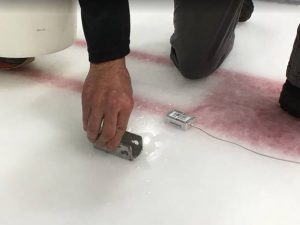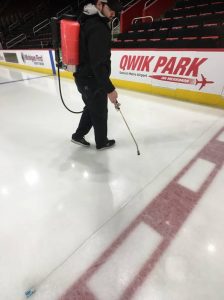NBC Sports Mikes the Ice for U.S. Figure Skating Championships
Six microphones are embedded in various places in the rink
Story Highlights
The 2019 GEICO U.S. Figure Skating Championships are taking place through Jan. 27 at the Little Caesars Arena in Detroit, where the temperature was 3 F Sunday night. But NBC Sports’ experience with figure skating in another, equally frigid venue is helping make the broadcast of this year’s U.S. national figure-skating championships sound as sharp as the skate blades themselves.

A notch to accommodate the mic casing is melted into the ice, along with a narrow trench for the cable.
“The idea of using under-ice contact mics for NBC’s coverage of the 2019 USFSA championships came up last minute,” says Karl Malone, director of sound design, NBC Olympics, who oversaw the Peacock Network’s audio for the 2018 Winter Olympics. “Christopher Allan, our NBC Olympics figure skating A1, contacted me and asked if it were possible to get some mics for the figure-skating nationals in Detroit. We had previously had conversations on how the ice mics worked so well in the Olympics in PyeongChang, which Christopher mixed, and we had spoken about how we should try to work on using more of them in some of the bigger NBC events at home in the U.S.”
Malone says mics embedded in a sports rink’s ice can be as sonically effective as, for instance, the microphones increasingly used around home plate for MLB games, putting a sound-capture device as close as possible to where an athlete’s prowess meets the object of the game. In this case, NBC Sports deployed the Audio-Technica AT880s piezo-electric microphones, the same ones it used in South Korea at the Olympics.
“The advantage to using contact mics is that we can isolate the sound of the skates on the ice from the above-ice sounds of the crowd and particularly music, which tends to bleed into normal boundary and camera-shotgun mics,” Malone explains. “Isolating the skates’ sound gives us the ability to create a more controlled mix and allows us to have a much fuller and cleaner music mix without the slap of the music in the big arena.”
In Detroit, however, besides securing the U.S. Figure Skating Association’s assent for the microphone project, the venue itself had to accommodate not only the figure-skating event but the NBA’s Detroit Pistons home games on Jan. 18 and 19, which overlapped the start of the figure-skating event. The arena would have to build the figure-skating ice on top of hockey ice, cover it for two days of basketball, and then uncover and load it in for figure skating.
Malone says the USFSA was very accommodating, once folks there saw NBC Sports’ detailed process.
“We had documented the procedure for them, including the distances of the microphones from the surface of the ice,” he says. “The venue ice technicians also agreed that they could do it while maintaining the consistency of the ice. At that point, the USFSA were very supportive of what we wanted to do from a creative side. As with all broadcast-audio encroachments onto the field of play, the safety and security of the athlete is the main concern, as is the fact that any installation cannot hinder or affect the performance of the athlete.”
Icing the Mic
Six of the waterproof AT880 PZM mics were installed. The venue’s ice technicians used a heated metal block to melt a notch in the ice the same size as the mic casing and positioned the mic in it, with a narrow trench for the cable, which was laid 12-15 ft. from the dasher, or side barrier. They sprayed the assembly with water, which froze solid about a quarter inch into the hockey ice, which was already in place. The microphones were powered by 48 V phantom power from the console, to prevent the significant decrease in battery performance that occurs at temperatures below 32 F.
After installation of the six microphones, the venue staff painted over the complete field of play to cover the existing hockey faceoff spots, circles, and lines and installed the appropriate figure-skating and sponsorship logos. They then laid down 1.5 in. of ice for the figure-skating competition. At that point, the microphones were 1.75 in. below the top of the ice.

After being buried in the ice, the mic is sprayed with water and freezes into the hockey ice, over which the figure-skating ice will be laid.
The rink was covered, and a basketball floor was laid on top for the two Detroit Pistons home games and subsequently removed for the figure-skating event.
The embedded microphones add a crucial aural component to the viewing experience: putting viewers not only in the stands but also, to an extent, inside the heads of the judges.
“The piezo element senses the vibrations of the skates through the solid ice, picking up only those vibrations,” Malone explains. “It does not pick up normal acoustic sound through the air. We placed one in each corner of the rink, where the jumps tend to land, one far center, and one near center in front of the judges panel. Figure-skating jumps are judged on a number of criteria, including the landing. How cleanly or not the athlete lands on the ice is heard by the judges in the form of noisy or scraping skates.”
Viewers at home will hear what the judges are listening for.
Malone says this is the first time that NBC Sports has installed microphones directly onto ice and then covered them with new ice. As with any transducer that’s beyond the reach of the crew, there’s some anxiety: “With any new difficult mic install, you are just waiting for the A1 to plug them up to the console and say “Yes, I’ve got the mics.”
But experience suggests that those ice mics will substantially enhance the experience of both those watching and those doing the mixing.
“It’s going to make a huge difference in being able to control the balance of music and skate sounds,” Malone says. “And the real armchair enthusiasts [might even be able to tell] the difference between a Salchow and a triple Lutz jump.”
